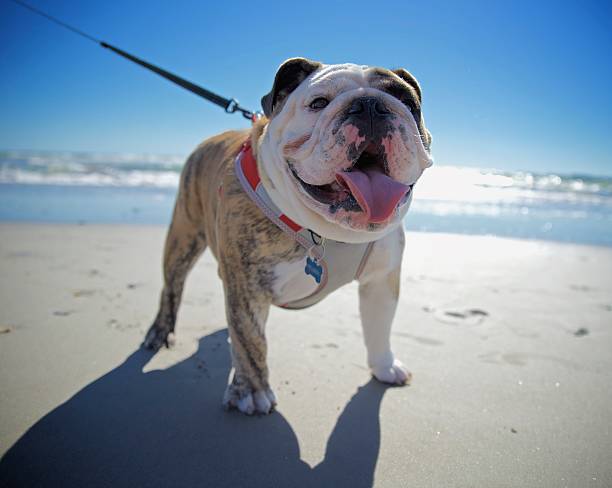The Valley Bulldog, a cherished emblem of resilience, loyalty, and spirited charm, finds a special place in the hearts of dog enthusiasts and families alike. With its intriguing blend of ancestry, distinctive appearance, and endearing personality traits, this breed has firmly established itself as a beloved companion, bearing the legacy of its heritage and a testament to companionship.

| Category (Explanation) | Breed Information |
|---|---|
| Year of Breed Conception | 20th century |
| Country of Origin | Canada |
| Weight (Male) | 60-85 lbs (27-39 kg) |
| Weight (Female) | 48-70 lbs (22-32 kg) |
| Coat Type | Short, smooth |
| Color Variations | Brindle, solid red or white, often with black mask |
| Shedding Level | Low to moderate |
| Height (cm & in) | 15-17 inches (38-43 cm) |
| Breed Size | Medium |
| Trainability | Moderate |
| Mental Needs | Moderate |
| Intelligence Level | Moderate |
| Energy Level | Moderate to high |
| Agility | Moderate |
| Loyalty | High |
| Playfulness | High |
| Exercise Needs | Regular exercise and play |
| Guarding Proficiency | Moderate |
| Sociability with Children | High |
| Barking Level | Low to moderate |
| Digging Tendency | Low to moderate |
| Destructive Behavior | Low to moderate |
| Drooling Level | Low |
| Obedience Level | Moderate |
| Apartment Friendly | Yes, with proper exercise and mental stimulation |
| Inherent Prey Drive | Moderate |
| Physical Risk to Others | Low |
| Travel Fatality Risk | Low |
| Allergen Potential | Low (considered hypoallergenic) |
| Health Concerns | Hip dysplasia, respiratory issues |
| Average Life Expectancy | 10-12 years |










































































Woof Mastery is reader supported and our articles may contain affiliate links.
Instead of running third party ads that we have no control of we only use links from high-quality companies we are directly partnered with. Making use of these links come at no cost to you our reader, and in many cases have the extra benefit of discounted rates or sign up bonuses.
If you’re interested you can read more about our affiliate policy here.
We appreciate your support and always insure that the products and services we recommend are high-quality, helpful and relevant to the subject at hand!
The Valley Bulldog’s history is a fascinating narrative that unfolds in the picturesque landscapes of Annapolis Valley, Nova Scotia. Bred by crossing the Boxer and English Bulldog in the mid-20th century, this breed was crafted for the purpose of farm work and companionship. The Valley Bulldog quickly became known for its unwavering loyalty and tenacity.
These dogs played crucial roles on farms, assisting in various tasks and forming deep bonds with their owners. Today, they remain a testament to the enduring spirit of working dogs and continue to bring joy and devotion to countless families in Nova Scotia and beyond.

What sets the Valley Bulldog apart is its affectionate and friendly nature combined with a strong, muscular build. These dogs are known for their loyalty and adaptability, making them great family pets. Valley Bulldogs balance their robust appearance with a heart full of love, earning them a special place in the hearts of their owners.
Their traditional role involved working on farms, helping with tasks, and being devoted companions.
Valley Bulldogs are renowned for their charming and affectionate personalities. They are known to be fiercely loyal, deeply affectionate, and incredibly protective of their families.
These dogs have a remarkable ability to form strong bonds with their owners and are often described as gentle giants, particularly with children. Their innate intelligence and willingness to please make them highly trainable and versatile companions. Valley Bulldogs are the kind of dogs that will not only guard your home but also your heart.
They can be incredibly gentle and nurturing, displaying a sense of responsibility toward their family that is heartwarming. While they can be initially reserved with strangers, they take their role as protectors seriously and extend their loyalty wholeheartedly when trust is established. Valley Bulldogs epitomize the perfect blend of strength and affection and can truly be considered as loving and loyal family members.
Valley Bulldogs typically exhibit a loving and loyal temperament. While affectionate with their families, they may display protective instincts that require proper training and socialization to avoid overprotectiveness or aggression towards strangers. Territorial behavior can surface, and they may show occasional stubbornness, emphasizing the need for consistent and patient training.
Given their strength and size, leash training is essential to maintain control. Careful introductions are advised when interacting with other dogs, especially those of the same sex. Early training and socialization play a pivotal role in fostering a well-adjusted and balanced temperament in this breed.
Valley Bulldogs are medium-sized canines known for their unique blend of strength and agility. Their robust, muscular build gives them a distinctive appearance. These dogs possess a square-shaped head, which is more prominent in males, characterized by a broad, well-defined jaw and powerful cheeks. When you look into their almond-shaped eyes, you’ll notice various shades of brown, adding depth to their expressive gaze.
Ears among Valley Bulldogs can be natural, semi-pricked, or cropped, depending on individual preference and regional regulations. Their coat is a marvel, short and dense, hugging their frame snugly. It often showcases a striking combination of white with eye-catching patches of brindle, red, or brown.
Valley Bulldogs boast loose, thick skin, particularly noticeable around the neck, where it forms charming wrinkles, a feature more prominent in males. Their muscular neck gracefully transitions to a broad chest and sturdy, straight legs. The tail, usually straight and tapered, adds to their overall balance and grace.
In terms of size, males stand proud at heights ranging between 18 to 22 inches (46-56 cm) at the shoulder, while females are slightly more refined in stature. Weight-wise, males tip the scales between 50 to 85 pounds (23-39 kg), whereas females tend to be a touch lighter.
Overall, Valley Bulldogs personify an agile, well-proportioned physique, underlining their history as reliable and active companions. Their appearance radiates confidence and athleticism, with males possessing a more robust and imposing presence compared to their female counterparts. |
Valley Bulldogs exhibit a range of appealing color variations that contribute to their distinctive appearance. The most common color varieties for Valley Bulldogs include:
Valley Bulldogs have a low shedding level. They are not heavy shedders, and their shedding is generally minimal year-round. Regular grooming can help manage shedding by removing loose fur and promoting a healthier coat. Brushing your Valley Bulldog once or twice a week with a soft bristle brush can help keep shedding under control.
Factors that affect shedding in Valley Bulldogs can be influenced by genetics, diet, and overall health. Providing a well-balanced diet with essential nutrients can contribute to a healthy coat and potentially reduce shedding. Regular exercise and mental stimulation are important for their overall health and coat condition.
Valley Bulldogs have a combination coat texture stemming from both the Boxer and the Bulldog. Their coat is short, making them look sleek and low maintenance, but grooming is still essential for overall health.
Brushing: Bi-weekly sessions with a soft-bristle brush can help remove loose fur and minimize shedding. This also massages their skin, distributing natural oils and promoting a soft, shiny coat.
Bathing: While they don’t require frequent baths, once every 4-6 weeks or when they’ve had a muddy playtime will keep their coat and skin in top condition. Always use a dog-specific shampoo to avoid skin irritations.
Ears: These should be cleaned weekly. Given their unique shape, they can harbor moisture, leading to infections. A dog ear cleaner or a simple home-made solution of diluted apple cider vinegar can help.
Nails: Long nails can become painful. Trim them every 2-3 weeks using a dog nail clipper or grinder.
Teeth: Oral hygiene is critical for all dogs. Brushing the Valley Bulldog’s teeth at least thrice a week can ward off dental diseases. Consider using dental chews for added protection.
Wrinkle Care: While they aren’t as wrinkled as some of their Bulldog ancestors, those they have, especially around the nose and eyes, should be kept clean and dry.
Eye Care: Regularly check for any signs of redness, irritation, or excessive tearing, wiping away any discharge with a clean cloth.
Valley Bulldogs have a moderate activity level. They are known for their friendly and affectionate nature. Here are some key points to consider about their activity level:
Valley Bulldogs are moderately intelligent dogs. Their intelligence is characterized by a combination of problem-solving abilities, adaptability, and a strong desire to please their owners. Here are some key points about their intelligence:
While Valley Bulldogs may not top the list in terms of problem-solving or obedience, their intelligence is more than sufficient for being excellent companions and working dogs. Training, socialization, and mental stimulation are essential to help them reach their full potential and become well-rounded and obedient pets.
Valley Bulldogs flourish with mental activities. Challenge them with toys that stimulate their intellect, such as treat-dispensing gadgets, agility drills, or fetching games.
Social Interaction: They are friendly canines that crave frequent bonding with their human counterparts. Isolation can bring about feelings of sadness, so it’s essential they get regular human interaction.
Exercise: Regular movement doesn’t only keep their physique in check; it’s pivotal for their mental well-being. An energetic romp or walk can help dispel pent-up energy.
Training and Obedience: Valley Bulldogs are responsive to obedience classes which mentally engage them and solidify the bond with their caregivers. Adopt a positive, reward-based approach for optimal results.
Routine and Structure: Valley Bulldogs find solace in knowing their day-to-day schedule. A stable routine imparts a sense of safety and wards off nervousness.
Affection and Attention: Embrace and give your undivided attention to your Valley Bulldog. Their inherent affectionate nature requires ample reciprocation.
Socialization: To mold them into adaptable adults, early exposure to diverse scenarios, beings, and surroundings is fundamental.
Safe Environment: Their home base should be peaceful and risk-free, offering them a dedicated sanctuary for moments of solitude.
Consistency: Steadiness in commands and daily life assures your Valley Bulldog of their place in the household, reinforcing their trust.
Enter The Woof Mastery

Before bringing a Valley Bulldog into your home, it’s crucial to understand their needs. These dogs are known for their friendly and affectionate nature. They require regular exercise and mental stimulation to stay happy and healthy. Training and socialization are essential to ensure they are well-behaved. Health concerns specific to the breed should be monitored.
Potential owners should be prepared for grooming needs and be aware of any breed-specific laws in their area. Responsible ownership includes providing ample love, attention, and a secure environment to ensure the well-being of these loyal and spirited companions.
Valley Bulldogs, a mix of the Boxer and the English Bulldog, have the potential to pose a physical danger if they are not properly socialized, trained, or managed. A dog’s behavior leans on factors such as individual temperament, upbringing, training, and owner commitment. Here’s an overview of their potential physical danger:
Valley Bulldogs are renowned for their charming and affectionate personalities. They are known to be fiercely loyal, deeply affectionate, and incredibly protective of their families. These dogs have a remarkable ability to form strong bonds with their owners and are often described as gentle giants, particularly with children.
Their innate intelligence and willingness to please make them highly trainable and versatile companions. Valley Bulldogs are the kind of dogs that will not only guard your home but also your heart. They can be incredibly gentle and nurturing, displaying a sense of responsibility toward their family that is heartwarming.
While they can be initially reserved with strangers, they take their role as protectors seriously and extend their loyalty wholeheartedly when trust is established. Valley Bulldogs epitomize the perfect blend of strength and affection and can truly be considered as loving and loyal family members.
Valley Bulldogs, known for their combination of Boxer and English Bulldog lineage, have distinct swimming traits. Here are some factors to consider:
While some Valley Bulldogs may enjoy water play or a brief swim, it’s crucial to be attentive to their signals and prioritize their safety.
Valley Bulldogs, similar to other canine breeds, use an assortment of vocalizations for communication. Here’s an insight into their vocal habits:
Understanding the different noises a Valley Bulldog makes is vital for owners. While many sounds are expressive, some might hint at a specific need or discomfort. Positive reinforcement can be effective in guiding their vocal habits.
Valley Bulldogs thrive in homes where they receive love, structure, and ample opportunities for socialization. Here are some ideal living conditions for Valley Bulldogs:
Challenges:
When it comes to travel fatality risk for Valley Bulldogs, consider the following potential constraints:
By keeping these in mind, traveling with your Valley Bulldog can be much safer.
Valley Bulldogs may be prone to specific health concerns. While not all individuals will experience these issues, it’s essential for Valley Bulldog owners to be aware of potential health problems and work with veterinarians to maintain their pets’ well-being. Common health concerns in Valley Bulldogs include:
Regular veterinary check-ups, a balanced diet, proper exercise, and responsible breeding practices can help mitigate some of these health concerns. It’s crucial for Valley Bulldog owners to work closely with their veterinarians to monitor their pets’ health and address any issues promptly.
For the optimal health and well-being of Valley Bulldogs, it’s essential to follow these tailored nutritional habits and best practices:
Breed-Specific Laws (BSL): Valley Bulldogs might occasionally come under breed-specific laws (BSL) in certain areas. Such laws are typically set at the local or municipal level and can vary across different jurisdictions.
Types of Restrictions: Regulations concerning Valley Bulldogs could include mandatory spaying/neutering, unique licensing, obligatory liability insurance, muzzling when in public areas, and in rare instances, bans on ownership, contingent upon local laws.
Rationale for BSL: BSLs usually stem from concerns related to public safety, especially when particular breeds are involved in negative incidents. Although Valley Bulldogs are known for their affable nature, they might face BSL scrutiny due to associations with other bulldog breeds.
Controversy: It’s noteworthy that BSL continues to be a subject of debate. Many believe that such regulations unfairly categorize breeds rather than focusing on individual dog behavior, with the emphasis being on training and responsible ownership.
Local Regulations: For those considering a Valley Bulldog, it’s essential to consult local animal control or governmental entities to understand any breed-specific regulations in the area.
Woof Mastery is reader supported and our articles may contain affiliate links.
Instead of running third party ads that we have no control of we only use links from high-quality companies we are directly partnered with. Making use of these links come at no cost to you our reader, and in many cases have the extra benefit of discounted rates or sign up bonuses.
If you’re interested you can read more about our affiliate policy here.
We appreciate your support and always insure that the products and services we recommend are high-quality, helpful and relevant to the subject at hand!
Myth 1: Valley Bulldogs are Aggressive by Nature
Myth 2: They are High-Energy Dogs
Myth 3: They Can’t Tolerate Cold Weather
Myth 4: They are Not Good with Children
Myth 5: They Shed Excessively
Myth 6: They Don’t Require Training
Myth 7: They are Always Good with Other Dogs
Myth 8: They Are All the Same Size
Myth 9: They are Unhealthy Dogs
Myth 10: They are Always Clingy
The Valley Bulldog holds cultural significance in various contexts:
While there may not be as many famous Valley Bulldog owners as there are for other dog breeds, here are a few notable individuals who have been associated with Valley Bulldogs:
Valley Bulldogs, like many other dog breeds, have faced several threats and challenges over the years. Some of the significant threats and issues that have affected the breed include:
The Valley Bulldog is believed to have been developed from a combination of various breeds, with the primary ancestors being the English Bulldog and the Boxer. The breed’s development occurred in the Annapolis Valley of Nova Scotia, with influences from regional strains and breed types. The specific breeds and strains that contributed to the Valley Bulldog’s development include:
Valley Bulldogs are a delightful blend of charm and loyalty, making them wonderful family companions. With their endearing personality and gentle nature, they effortlessly integrate into our lives, becoming cherished members of our households. These dogs excel as watchdogs, displaying protective instincts that further solidify their role as guardians of our homes.
They are known for their adaptability, thriving in various living conditions, and requiring only minimal grooming. Their athletic prowess and playful spirit cater to active individuals and families, making them excellent playmates. Their intelligence shines in activities and training.
Beyond their physical attributes, Valley Bulldogs bring a unique charm to every household, filling the air with their presence. Their versatility is a testament to their adaptability, transitioning effortlessly from beloved family pets to diligent working dogs.
Most importantly, Valley Bulldogs offer profound and unconditional love, forging an unbreakable bond that enriches our lives. If you’re seeking a loyal and affectionate companion, embrace the love and devotion of a Valley Bulldog.